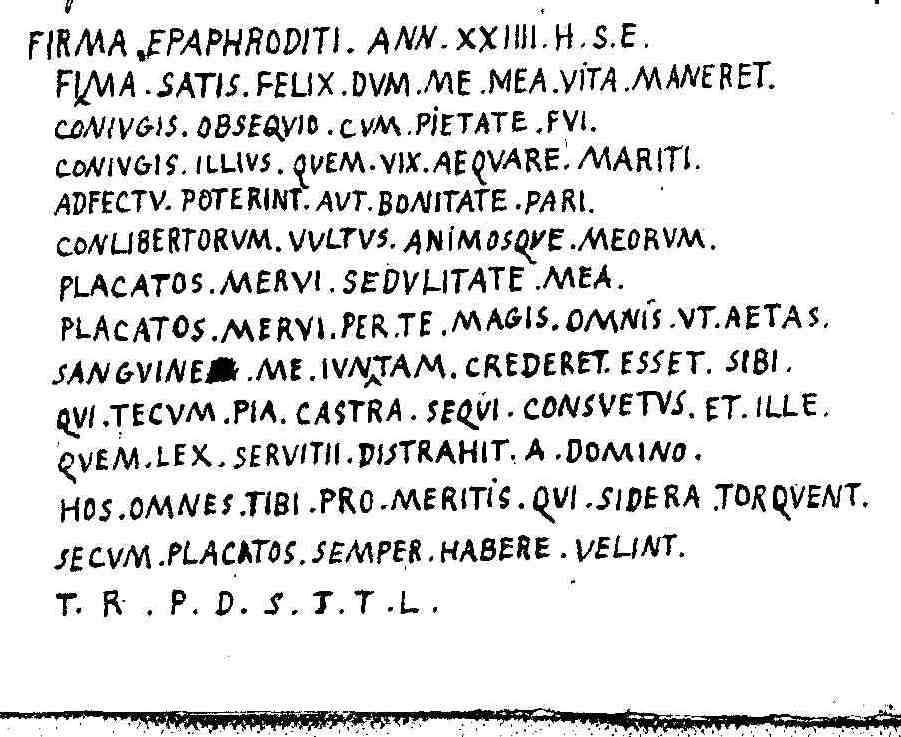Epitaph of Firma
Reference CIL II 1399, CLE 1140 | Description | Lyrics | Location | Chronology | Epigraphic edition | Translation | Apparatus | Comentary | Type of verse | Text divided into verses and metric signs | Images | Bibliography | Link to DB | Author |
Epitaph of Firma
Description
- Idno filename 22/01/0048
- Type of inscription: Sepulcralis
- Material Description: Very thin marble plaque. Scarcely one span and a half long, and one, or just over, wide Caro
- Dimensions height/width/depth (cm): 31.5/21/-
-
Epigraphic field:
- Layout: Hederae pointing left in the praescriptum and triangular interpunctions in the subscriptum; in the carmen there are interpunctions only between the first four words of the first verse, according to the transcription by Siruela.
- Lost
Lyrics
- Font:Libraria
- Description of the letters:Praescriptum with larger letters: large letters for the name and age of the deceased (…) and an elegant epigram in small but clearly legible letters Caro. Possibly book script Gimeno-Stylow, from the transcription by Siruela. Hederae pointing left in the praescriptum and triangular interpunctions in the subscriptum; in the carmen there are interpunctions only between the first four words of the first verse, according to the transcription by Siruela. L. 1, Epaphroditi with ligature HR and -iti cramped in D. Some letters are written in a larger size: l. 9: R; l. 10: R; l. 11: E and P; l. 12: R; l. 13: I, B, R; l. 14: R.
Location
- Place of discovery: Found in Marchena, a la hermita de San Roque (at the hermitage of San Roque) Caro.
- Geolocation
- Location with Modern Nomenclature España / Sevilla / Marchena
- Location with Old Nomenclature Hispania / Baetica / Astigitanus / Carula
Chronology
- Inscription's dating: Between year 100 and year 200
Type of verse
- Type of verse: Dactílico (dístico elegíaco)
- Verse/line correspondence: Si
- Prose/verse distinction: Si
Epigraphic edition
Firma ❦ Epaph⁽ro⁾diti
ann(orum) ❦ XXIIII ❦ h(ic) ❦ s(ita) ❦ e(st) ❦
Firma ▴ satis ▴ felix ▴ cum me (!) mea vita maneret
coniugis opsequio (!) cum pietate fui
5 coniugis illius quem vix aequare mariti
adfectu poterint aut bonitate pari
conlibertorum vultus animosque meorum
placatos merui sedulitate mea
placatos merui per te magis omnis ut aetas
10 sanguine me iunctam crederet esse sibi
qui tecum pia castra sequi consuetus et ille
quem lex servitii distrahit a domino
hos omnes tibi pro meritis qui sidera torquent
secum placatos semper habere velint
15 t(e) ▴ r(ogo) ▴ p(raeteriens) ▴ d(icas) ▴ s(it) ▴ t(ibi) ▴ t(erra) ▴ levis ▴
Text divided into verses and metric signs
Firma satis felix, cum me mea vita maneret, lkk|l/l|l/l|l/kk|lkk|l~
coniugis opsequio cum pietate fui, lkk|lkk|l||lkk|lkk|~
coniugis illius, quem vix aequare mariti lkk|ll|l/l|l/l|lkk|l~
adfectu poterint aut bonitate pari. ll|lkk|l||lkk|lkk|~
5 Conlibertorum vultus animosque meorum ll|ll|l/l|l/kk|lkk|l~
placatos merui sedulitate mea, ll|lkk|l||lkk|lkk|~
placatos merui per te magis, omnis ut aetas ll|l/kk|l/l|l/kk|lkk|l~
sanguine me iunctam crederet esse sibi: lkk|ll|l||lkk|lkk|~
qui tecum pia castra sequi consuetus et ille ll|lkk|lk/k|l/l|lkk|l~
10 quem lex servitii distrahit a domino. ll|lkk|l||lkk|lkk|~
Hos omnes tibi pro meritis qui sidera torquent ll|l/kk|l/kk|l/l|lkk|l~
secum placatos semper habere velint. ll|ll|l||lkk|lkk|~
Translation
Firma, (wife) of Epaphroditus, of twenty-four years, is buried here. I, Firma, while I lived, was very happy with the consideration of my husband and my obedience to him, that husband who could barely compare to other husbands in similar affection or goodness. I was deserving of the favouring looks and good will of my fellow freedmen thanks to my dutifulness; but I merited their friendly disposition more because of you, so that all of them, whatever their age, considered me to be of their own blood, both those who were accustomed to following you obediently to the camps and those whom the law of slavery separated from their master. May those who make the stars turn under their authority make them all well disposed to you thanks to your merits. I beg you say as you pass by: ‘may the earth rest lightly on you’.
Bibliography
Agustín 1570–1580, 11r., cui misit Anonymvs; Caro 1621/25 (BNM ms. 9858, 239v.–240r. et BRAH ms. 9/5784, 10r.–10v. et 1932–1933, 163–164) (inde Velázquez ms. saec. XVIII, 30c.); Caro 1634, 146v. et 163r. (inde Maffei 1749, 423; Gutiérrez Bravo 1771, 174r.; Burmann 1773, 40–41; Meyer 1835, I 2, 123 et II 2, 87 et 170; Hübner II 1399 [Bücheler, CLE 1140, cuius exemplum in linguam Hispanicam vertit Fernández Martínez 1998-99; Cholodniak 1904, 2; Vives, ILER 5793] et id., cf. EE VIII p. 352; Ilewycz 1918, 144; Santero 1978, 85 et 157, 60; González Fernández, CILA II, 827; Thigpen 1995, 48–55, 5, quae in linguam Anglicam vertit); Siruela saec. XVII, 7v. (inde Gimeno – Stylow 1998, 94–95 [imago in 142]); ex eis Martín Camacho 2009, 203–223 et CLEB ES, SE2, qui in linguam Hispanicam vertit (HEp 2009, 307). – Cf. Mariner 1952, 67, 77–78, 102, 204; Hernández Pérez 2001a, 144–145, 157, 165, 178, 181, 280 et 290; di Stefano 2008, 307.
Apparatus
1 Epaphrodeti Anonymvs, Caro 1621/25. – 2 in v. 1 integram scripsit Caro 1621/25 BNM, Velázquez, in v. 1 Ann · XXIIII · scripsit Caro 1621/25 BRAH, in v. 3 h · s · e · scripsit Caro 1621/25 1932, h · s · e · omisit Caro 1634. – 3 foelix Anonymvs; dum Caro 1621/25; mi legendum aut me altera forma dativi est Meyer, González Fernández. – 4 obsequio Caro 1621/25, Caro 1634; frui Anonymvs. – 5 quum Caro 1621/25. – 6 ad fectu Caro 1621/25 BNM, BRAH, ad festu Caro 1621/25 1932; poterunt Maffei, Meyer, González Fernández, potuerunt Bonada (apud Meyer). – 7 animosq Caro 1634. – 9 etas Caro 1621/25 BNM. – 10 iunctum Caro 1621/25; tibi Caro 1621/25 BNM, BRAH, Schrod. (apud Meyer). – 11 siqui Caro 1621/25 1932; e ille Siruela. – 12 sex Caro 1621/32 BNM, BRAH. – 13 has Caro 1621/25; omnis Siruela. – 15 t · r · p · d · s · t · t · l · Caro 1621/25; h · s · e · s · t · t · l · Caro 1634; integram omisit Maffei.
Comentary
Six perfect elegiac distichs. Carefully executed structure and layout of content, placed in the mouth of the deceased, but praising her husband, Epaphroditus, more than herself, vid. Martín Camacho 2009.
- L. 3: vid. Verg. 5,724 (and 6,608 and 661). Use of cum for dum is common, vid. Fernández Martínez 1990. Me for mi (= mihi), cf. Verg. Ecl. 4,53, vid. Meyer. L. 4: obsequium (opsequio for obsequio) and pietas, qualities frequently praised in the case of a marriage between a man and his freedwoman, cf. CLE 56,2-3 or CLE 1988,15-16. L. 5: coniugis and mariti, understood as poetic variatio and not as different types of marriages (as interpreted by Agustín and Burmann). L. 6: Poterint for poterunt, by analogy with future perfect ending -int, cf. CLE 610,9-10 and vid. Mariner 1952, 67. L. 8: Epaphroditus, freedman, has control over other freedmen, including his own wife Firma, whose sedulitas, together with the contribution of her husband (per te magis, l. 9), have earned her the appreciation of her fellow freedmen, vid. Martín Camacho 2009. Ll. 11-12: problems identifying the people referred to in qui tecum pia castra sequi consuetus, and also ille quem lex servitii distrahit a domino. The term conlegium castriense is used to refer to the funerary colleges (thus referring metaphorically to their internal organisation or residential structure), cf. CIL VI,7281, vid. Di Stefano 2008; castra pia may refer to a colegium humiliorum (vid. Santero 1985, 85), as indicated by pia, cf. CIL II 1976, pia in collegio. This could explain the distinction between fellow freedmen and slaves expressed in the structure qui… et ille: it could refer to the differences in rank between (lex servitii), freedmen and free children, vid. CIL XIV, 2112, lex cultorum Dianae et Antinoi, vid. Di Stefano 2008, 307. L. 14: secum depending on torquent, in the usual sense of “person under whose orders or mandate one acts”, cf. OLD, s.v. cum, 4 and Verg. Aen. 7,93 and 8,141.
Author
- Author:J. Martín Camacho
- Last Update2024-02-25 19:08:55
You can download this





